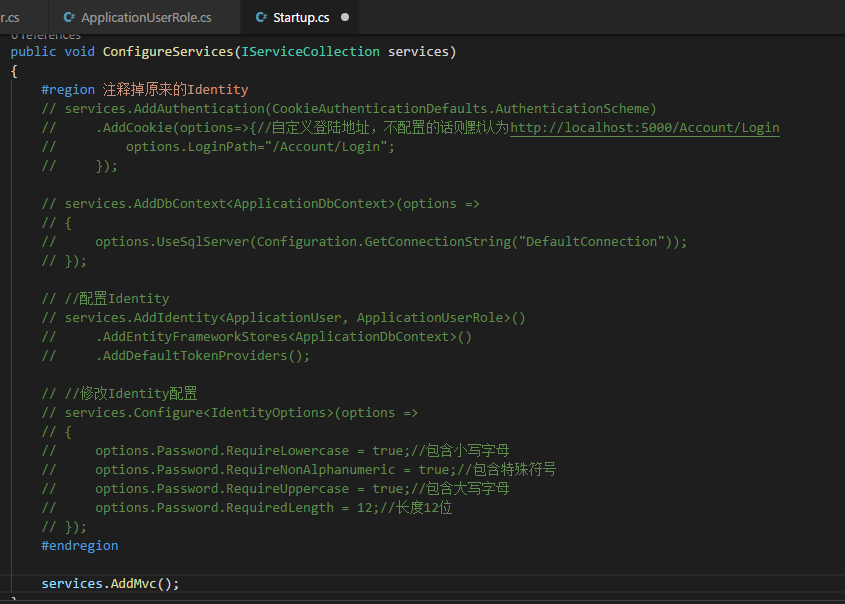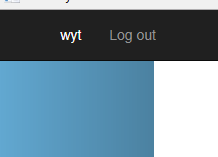【ASP.NET Core分布式项目实战】(二)oauth2 + oidc 实现 server部分
资料
我们基于之前的MvcCookieAuthSample来做开发
MvcCookieAuthSample下载地址:https://files.cnblogs.com/files/wyt007/ASPNETCore%E5%BF%AB%E9%80%9F%E5%85%A5%E9%97%A8.rar
MvcCookieAuthSample教程地址:http://www.cnblogs.com/wyt007/p/8204731.html
正文
给网站设置默认地址 http://localhost:5000

首先,我们将之前写的系统的Identity注释掉,在Startup.cs中

第一步:添加Nuget包:IdentityServer4
我们可以在vscode中使用ctrl+P键来打开命令面板。然后输入nuget按回车,输入identityserver4后按回车来选择版本进行安装
第二步:添加Config.cs配置类
我们接下来添加一个Config.cs类,这个类是用来初始化IdentityServer的
using System.Collections; using System.Collections.Generic; using IdentityServer4; using IdentityServer4.Models; using IdentityServer4.Test; namespace MvcCookieAuthSample { public class Config { //所有可以访问的Resource public static IEnumerable<ApiResource> GetApiResources() { return new List<ApiResource> { new ApiResource("api1","API Application") }; } //客户端 public static IEnumerable<Client> GetClients() { return new List<Client> { new Client() { ClientId="mvc", AllowedGrantTypes= GrantTypes.Implicit,//模式:最简单的模式 ClientSecrets={//私钥 new Secret("secret".Sha256()) }, AllowedScopes={//可以访问的Resource IdentityServerConstants.StandardScopes.Profile, IdentityServerConstants.StandardScopes.OpenId, }, RedirectUris={"http://localhost:5001/signin-oidc"},//跳转登录到的客户端的地址 PostLogoutRedirectUris={"http://localhost:5001/signout-callback-oidc"},//跳转登出到的客户端的地址 RequireConsent=false//是否需要用户点击确认进行跳转 } }; } //测试用户 public static List<TestUser> GetTestUsers() { return new List<TestUser>{ new TestUser{ SubjectId="10000", Username="wyt", Password="password" } }; } //定义系统中的资源 public static IEnumerable<IdentityResource> GetIdentityResources() { return new List<IdentityResource> { new IdentityResources.OpenId(), new IdentityResources.Profile(), new IdentityResources.Email() }; } } }
以上使用IdentityServer4测试数据类添加数据,直接存在内存中。IdentityServer4 是支持持久化。
第三步:添加Startup配置
引用命名空间:
using IdentityServer4;
然后打开Startup.cs 加入如下:
services.AddIdentityServer() .AddDeveloperSigningCredential()//添加开发人员签名凭据 .AddInMemoryApiResources(Config.GetApiResources())//添加内存apiresource .AddInMemoryClients(Config.GetClients())//添加内存client .AddInMemoryIdentityResources(Config.GetIdentityResources())//添加系统中的资源 .AddTestUsers(Config.GetTestUsers());//添加测试用户
public void Configure(IApplicationBuilder app, IHostingEnvironment env, ILoggerFactory loggerFactory) { ... //app.UseAuthentication(); app.UseIdentityServer(); ...
接着安装UI,UI部分也可以自己编写,也就是登录 注销 允许和错误。
可以到 https://github.com/IdentityServer/IdentityServer4.Quickstart.UI/tree/release 下载,然后解压到项目目录下。
也可以使用命令提示符快速安装:
powershell iex ((New-Object System.Net.WebClient).DownloadString('https://raw.githubusercontent.com/IdentityServer/IdentityServer4.Quickstart.UI/release/get.ps1'))
在项目目录下打开命令提示符,输入以上命令。
更多信息,可以查看官方readme:https://github.com/IdentityServer/IdentityServer4.Quickstart.UI/blob/release/README.md
大神博客:https://www.cnblogs.com/linezero/p/identityserver4openidconnect.html
修改LoginViewModel,将Email改为UserName,并修改强类型视图的引用部分Login.cshtml
namespace MvcCookieAuthSample.ViewModels { public class LoginViewModel { //[Required]//必须的 //[DataType(DataType.EmailAddress)]//内容检查是否为邮箱 //public string Email { get; set; } [Required] public string UserName { get; set; } [Required]//必须的 [DataType(DataType.Password)]//内容检查是否为密码 public string Password { get; set; } } }
修改AccountController,原来的_userManager和_signInManager不再使用
using Microsoft.AspNetCore.Authentication; using Microsoft.AspNetCore.Authorization; using Microsoft.AspNetCore.Authentication.Cookies; using System.Security.Claims; using Microsoft.AspNetCore.Mvc; using System.Collections.Generic; using Microsoft.AspNetCore.Identity; using MvcCookieAuthSample.Models; using System.Threading.Tasks; using MvcCookieAuthSample.ViewModels; using IdentityServer4.Test; using System; namespace MvcCookieAuthSample.Controllers { public class AccountController : Controller { // private UserManager<ApplicationUser> _userManager;//创建用户的 // private SignInManager<ApplicationUser> _signInManager;//用来登录的 private readonly TestUserStore _users; public AccountController(TestUserStore users) { _users=users; } // //依赖注入 // public AccountController(UserManager<ApplicationUser> userManager, SignInManager<ApplicationUser> signInManager) // { // _userManager = userManager; // _signInManager = signInManager; // } //内部跳转 private IActionResult RedirectToLocal(string returnUrl) { if (Url.IsLocalUrl(returnUrl)) {//如果是本地 return Redirect(returnUrl); } return RedirectToAction(nameof(HomeController.Index), "Home"); } //添加验证错误 private void AddError(IdentityResult result) { //遍历所有的验证错误 foreach (var error in result.Errors) { //返回error到model ModelState.AddModelError(string.Empty, error.Description); } } public IActionResult Register(string returnUrl = null) { ViewData["returnUrl"] = returnUrl; return View(); } [HttpPost] public async Task<IActionResult> Register(RegisterViewModel registerViewModel, string returnUrl = null) { // if (ModelState.IsValid) // { // ViewData["returnUrl"] = returnUrl; // var identityUser = new ApplicationUser // { // Email = registerViewModel.Email, // UserName = registerViewModel.Email, // NormalizedUserName = registerViewModel.Email // }; // var identityResult = await _userManager.CreateAsync(identityUser, registerViewModel.Password); // if (identityResult.Succeeded) // { // //注册完成登录生成cookies信息 // await _signInManager.SignInAsync(identityUser, new AuthenticationProperties { IsPersistent = true }); // return RedirectToLocal(returnUrl); // } // else//注册失败 // { // //添加验证错误 // AddError(identityResult); // } // } return View(); } public IActionResult Login(string returnUrl = null) { ViewData["returnUrl"] = returnUrl; return View(); } [HttpPost] public async Task<IActionResult> Login(LoginViewModel loginViewModel, string returnUrl = null) { if (ModelState.IsValid) { ViewData["returnUrl"] = returnUrl; //var user = await _userManager.FindByEmailAsync(loginViewModel.Email); var user = _users.FindByUsername(loginViewModel.UserName); if (user == null) { ModelState.AddModelError(nameof(loginViewModel.UserName), "UserName not exists"); } else { if (_users.ValidateCredentials(loginViewModel.UserName,loginViewModel.Password)) { //是否记住 var prop = new AuthenticationProperties() { IsPersistent = true, ExpiresUtc = DateTimeOffset.UtcNow.Add(TimeSpan.FromMinutes(30)) }; //HttpContext.SignInAsync(user.SubjectId, user.Username, prop); await Microsoft.AspNetCore.Http.AuthenticationManagerExtensions.SignInAsync(HttpContext, user.SubjectId, user.Username, prop); } } //账号密码先不做验证,需要可以自己写 //await _signInManager.SignInAsync(user, new AuthenticationProperties { IsPersistent = true }); return RedirectToLocal(returnUrl); } return View(); } //登出 public async Task<IActionResult> Logout() { await HttpContext.SignOutAsync(); return RedirectToAction("Index", "Home"); } } }
接下来我们需要将原来的Program.cs中的数据库初始化的内容注释掉

然后我们就可以运行网站,输入用户名和密码进行登录了

新建客户端
新建一个MVC网站MvcClient
dotnet new mvc --name MvcClient
给网站设置默认地址 http://localhost:5001

MVC的网站已经内置帮我们实现了Identity,所以我们不需要再额外添加Identity引用
添加认证
services.AddAuthentication(options => { options.DefaultScheme = "Cookies";//使用Cookies认证 options.DefaultChallengeScheme = "oidc";//使用oidc }) .AddCookie("Cookies")//配置Cookies认证 .AddOpenIdConnect("oidc",options=> {//配置oidc options.SignInScheme = "Cookies"; options.Authority = "http://localhost:5000"; options.RequireHttpsMetadata = false; options.ClientId = "mvc"; options.ClientSecret = "secret"; options.SaveTokens = true; });
在管道中使用Authentication
app.UseAuthentication();
Login.cshtml 页面接收returnUrl进行跳转

<form method="post" asp-controller="Account" asp-action="Login"> <h4>Use a local account to log in.</h4> <hr /> @*用于登录后进行跳转*@ <input type="hidden" name="returnUrl" value="@ViewData["returnUrl"]" /> <div class="form-group"> <label asp-for="UserName"></label> <input asp-for="UserName" class="form-control" /> <span asp-validation-for="UserName" class="text-danger"></span> </div> <div class="form-group"> <label asp-for="Password"></label> <input asp-for="Password" type="password" class="form-control" /> <span asp-validation-for="Password" class="text-danger"></span> </div> <div class="form-group"> <button type="submit" class="btn btn-block btn-danger">Log in</button> </div> </form>
接下来我们在HomeController上打上 [Authorize] 标签,然后启动运行
我们这个时候访问首页http://localhost:5001会自动跳转到ocalhost:5000/account/login登录

登录之后会自动跳转回来

我们可以在Home/About页面将claim的信息显示出来
@{ ViewData["Title"] = "About"; } <h2>@ViewData["Title"]</h2> <h3>@ViewData["Message"]</h3> <dl> @foreach (var claim in User.Claims) { <dt>@claim.Type</dt> <dt>@claim.Value</dt> } </dl>

这边的内容是根据我们在IdentityServer服务中定义的返回资源决定的

-------------------------------------------
个性签名:独学而无友,则孤陋而寡闻。做一个灵魂有趣的人!
如果觉得这篇文章对你有小小的帮助的话,记得在右下角点个“推荐”哦,博主在此感谢!
万水千山总是情,打赏一分行不行,所以如果你心情还比较高兴,也是可以扫码打赏博主,哈哈哈(っ•̀ω•́)っ✎⁾⁾!








【推荐】国内首个AI IDE,深度理解中文开发场景,立即下载体验Trae
【推荐】编程新体验,更懂你的AI,立即体验豆包MarsCode编程助手
【推荐】抖音旗下AI助手豆包,你的智能百科全书,全免费不限次数
【推荐】轻量又高性能的 SSH 工具 IShell:AI 加持,快人一步
· .NET Core 中如何实现缓存的预热?
· 从 HTTP 原因短语缺失研究 HTTP/2 和 HTTP/3 的设计差异
· AI与.NET技术实操系列:向量存储与相似性搜索在 .NET 中的实现
· 基于Microsoft.Extensions.AI核心库实现RAG应用
· Linux系列:如何用heaptrack跟踪.NET程序的非托管内存泄露
· TypeScript + Deepseek 打造卜卦网站:技术与玄学的结合
· 阿里巴巴 QwQ-32B真的超越了 DeepSeek R-1吗?
· 【译】Visual Studio 中新的强大生产力特性
· 10年+ .NET Coder 心语 ── 封装的思维:从隐藏、稳定开始理解其本质意义
· 【设计模式】告别冗长if-else语句:使用策略模式优化代码结构